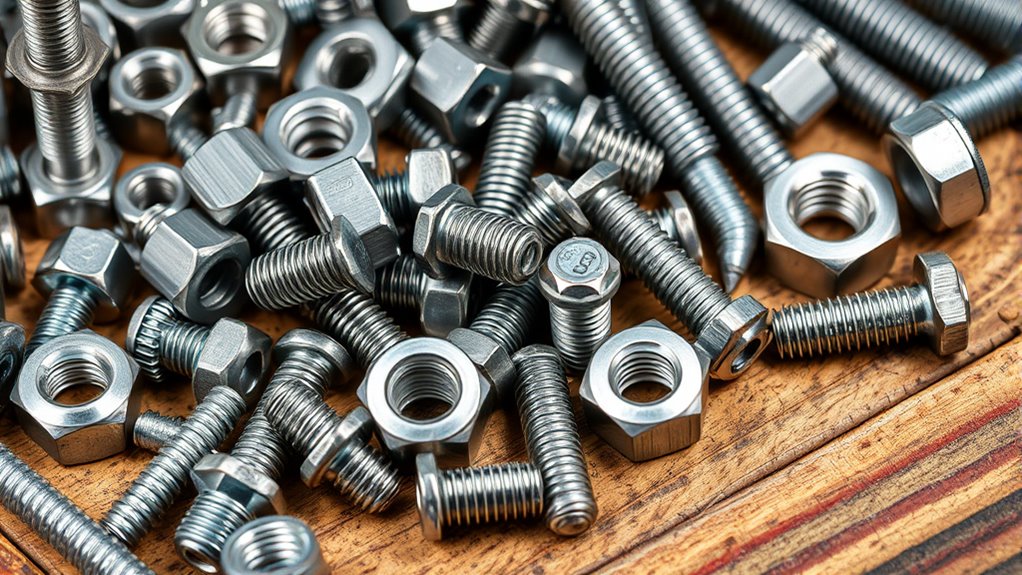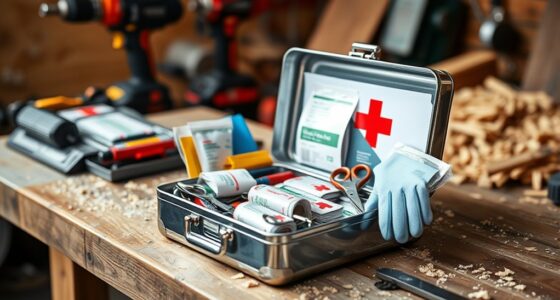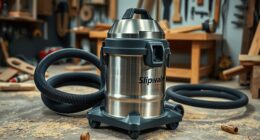To efficiently sort nuts, bolts, and screws, group them by size, type, and use. Use clear containers, labeled bins, or drawer organizers for quick identification. Consider wall-mounted racks or stackable boxes to maximize space. Keep frequently used items accessible and store less often used hardware away. Proper organization reduces clutter, saves time, and makes your workspace more productive. Continue exploring effective methods to turn your hardware chaos into streamlined order.
Key Takeaways
- Categorize nuts, bolts, and screws by size, type, and thread pitch for quick identification.
- Use labeled containers, drawers, or bins to organize hardware systematically.
- Implement wall-mounted racks or pegboards for frequently used fasteners.
- Utilize clear storage containers to visually access and distinguish hardware components.
- Tailor storage solutions to project needs to enhance efficiency and workspace tidiness.

Sorting hardware plays a crucial role in organizing and managing data efficiently. Whether you’re handling a large inventory of nuts, bolts, and screws or just trying to keep your workshop tidy, using the right organization techniques can make all the difference. When it comes to sorting hardware, the goal is to streamline access, reduce clutter, and ensure that every item has a designated place. This means adopting storage solution ideas that are both practical and adaptable to your needs. You want to find a system that minimizes time spent searching and maximizes productivity.
One of the most effective organization techniques is to categorize your hardware by size, type, or use. For example, small parts like screws can be grouped by diameter, length, or head type, while larger bolts might be separated by thread pitch or weight. Using clear containers or labeled bins allows you to quickly identify and retrieve items without rummaging through piles. Drawer organizers or stackable storage boxes work well for small parts and can be customized with dividers to keep everything neatly separated. When you label each compartment or container, you’ll avoid confusion and save time that might otherwise be spent sorting through mixed items.
Categorize hardware by size, type, or use to streamline access and reduce clutter efficiently.
Storage solution ideas should prioritize accessibility and space efficiency. Consider using wall-mounted racks or pegboards for frequently used hardware, so you can grab what you need without opening multiple containers. For less frequently accessed items, stackable bins or modular drawers fit nicely on shelves or in cabinets. Transparent containers are highly recommended because they let you see what’s inside at a glance, reducing the need to open each one. If you’re dealing with a large quantity of hardware, think about tiered storage systems that allow you to organize items by project or frequency of use. Additionally, incorporating electric tools with your hardware organization can streamline your workflow and improve efficiency. This way, you can keep your workspace tidy and avoid cluttered piles of loose hardware.
Incorporating organization techniques with effective storage ideas doesn’t have to be complicated or expensive. The key is to tailor your system to your specific needs—consider the types and quantities of hardware you handle regularly. Investing in stackable, labeled containers or modular shelving units can pay off in the long run by making your workspace more efficient. When everything is sorted and stored properly, you’ll minimize frustration, avoid misplaced items, and improve your workflow. Proper organization isn’t just about tidiness; it’s about creating a system that supports your productivity and makes your projects easier to manage.
Frequently Asked Questions
How Do I Choose the Right Hardware for Outdoor Projects?
To choose the right hardware for outdoor projects, consider material compatibility and hardware longevity. Use corrosion-resistant materials like stainless steel or galvanized hardware to withstand weather conditions. Guarantee the hardware matches the materials you’re working with to prevent deterioration or damage. By selecting durable, weatherproof options, you’ll extend the lifespan of your project and avoid frequent replacements, making your outdoor setup more reliable and long-lasting.
What Are the Most Corrosion-Resistant Materials for Hardware?
You should choose stainless steel, brass, or bronze for the most corrosion-resistant hardware. These materials resist galvanic corrosion and enhance material longevity, making them ideal for outdoor projects. Stainless steel, especially 316 grade, offers superior durability against moisture and chemicals. Brass and bronze are excellent options too, providing reliable corrosion resistance and ensuring your hardware lasts longer in harsh weather conditions.
Are There Eco-Friendly Options for Nuts, Bolts, and Screws?
Imagine planting a seed that grows into a sturdy tree—this is how eco-friendly nuts, bolts, and screws work. You can choose biodegradable fasteners that break down naturally, or opt for recycled metal hardware, giving old materials new life. These options reduce environmental impact, helping you build sustainably. By selecting eco-friendly fasteners, you’re supporting a greener future without sacrificing strength or durability in your projects.
How Can I Identify Counterfeit or Low-Quality Hardware?
To identify counterfeit or low-quality hardware, you should look for clear quality indicators like consistent threading, proper sizing, and smooth finishes. Conduct counterfeit detection by checking for official markings, certifications, and comparing weights with genuine items. Be cautious of cheap or uneven coatings, misshapen parts, or inconsistent branding. Trust reputable suppliers, and when in doubt, perform a test fit or consult manufacturer specifications to confirm you’re getting authentic, high-quality hardware.
What Tools Are Best for Installing Different Types of Hardware?
Think of yourself as a master builder, and your tools are your trusted allies. For installing various hardware, a power drill is perfect for quick, efficient work, especially with screws. For more delicate or precise tasks, screwdrivers—both flathead and Phillips—are your go-to. Keep a variety on hand, and you’ll confidently tackle any hardware installation, ensuring everything fits snugly and securely just like a true craftsman.
Conclusion
Sorting hardware like nuts, bolts, and screws might seem simple, but it’s vital for any project. Did you know that the hardware industry produces over 15 million tons of fasteners annually worldwide? That’s enough to build thousands of bridges! Properly sorting and organizing these tiny pieces guarantees safety, efficiency, and quality in your work. So next time you sort hardware, remember how important this step is — it keeps everything secure and running smoothly.









